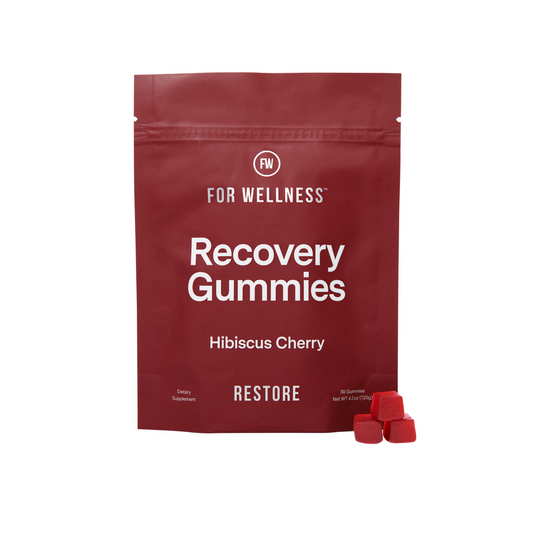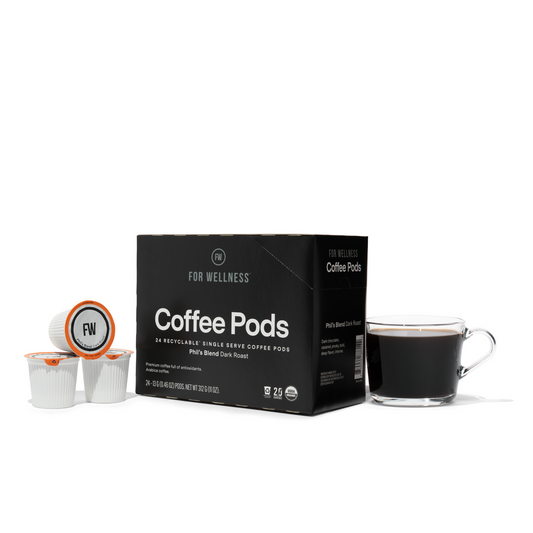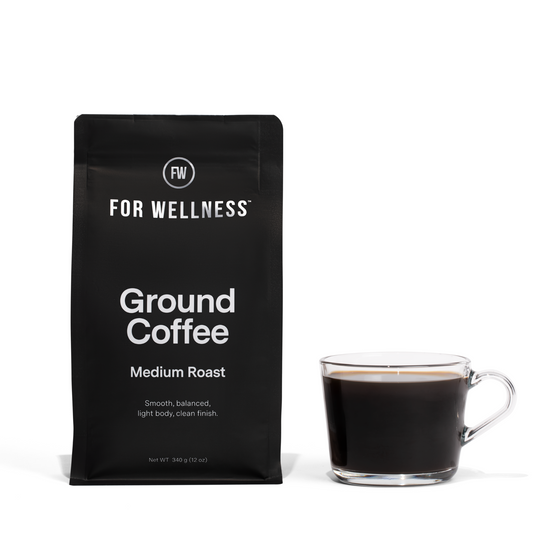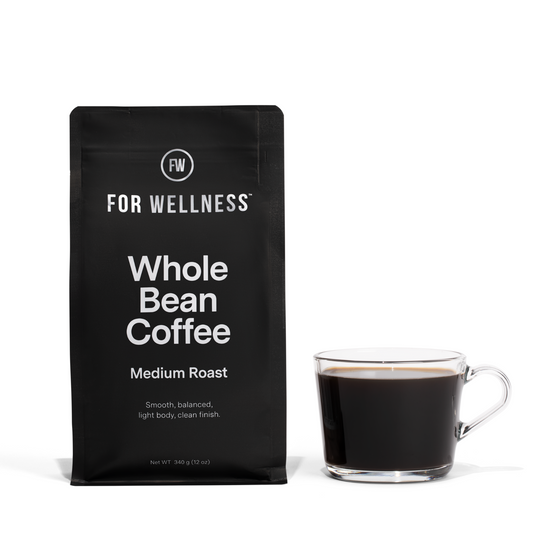You already know that your favorite blend of coffee is delicious, delivering a jolt of flavor and a much-needed burst of energy right from the first sip. However, did you also know that it can enrich your body and improve your overall wellness from the inside out?
There are many different compounds in coffee that make it one of the healthiest and most nutritious beverages to sip and enjoy. Many of these nutrients are classified as antioxidants.
What do they do, how do they work, and why are they so valuable? Today, we're diving into the world of coffee antioxidants and sharing all of the details you need to know.


The Good Stuff - Performance
-
One scoop will infuse your coffee with healthy ingredients
-
Ditch the bad stuff like sugar, dairy, and artificial creamers
-
Fights inflammation and supports skin and joint health
-
Makes your coffee taste great
What Are Antioxidants?
Before we get into all of the different types of antioxidants found in coffee, let's back it up a little. You've heard they're the cornerstones of good nutrition, but what are antioxidants in the first place?
In short, antioxidants are any type of man-made or natural substance that prevents or delays some type of cellular damage. Some of the most common ones are found naturally in fruits and vegetables, including selenium, manganese, carotenoids, flavonoids and phenols.
Why Do We Need Them?
Why is it important to eat and drink foods that contain a high amount of antioxidants? Put simply, these substances work to protect your cells against free radicals.
Free radicals are the molecules that your body produces as it breaks down food. It also makes them when you're exposed to certain environmental triggers, such as cigarette smoke or radiation.
Left to roam about freely, free radicals can damage your cells at the molecular level. This includes even the most important molecules, such as proteins and DNA. Over time, this damage can catalyze oxidative stress in your body, which increases your risk of developing certain health conditions, including heart disease and cancer.
Antioxidants help protect your cells from the damage that free radicals can cause. While you can take supplements that have been fortified with them, it's easier to get most of your antioxidants from a diet that's rich in healthy, natural nutrients.
Antioxidants aren't just found in coffee, you can also find them in fruits, vegetables, nuts and seeds, whole grains, herbs, and spices.
As an extra bonus, most of the foods above are also high in fiber but low in saturated fat and cholesterol. They're also chock-full of other vitamins and minerals that your body needs to perform at peak capacity.
While filling your plate with these colorful additions, remember to fill your cup, too. Coffee contains a rich array of antioxidants and makes an excellent complement to your daily regimen. In fact, one study found that just one cup of coffee can contain between 200 and 550 milligrams of antioxidants, all on its own!
A Closer Look at Coffee Antioxidants
Now that we know coffee is such a great source of antioxidants, let's dig a little deeper. What are the specific types of antioxidants you can expect to find in your morning brew?
While there's a long list of specific titles, most of the healthy vitamins and antioxidants in coffee fall into one of two categories:
- Hydrocinnamic acids
- Polyphenols
Let's break these down a little more.
Hydrocinnamic Acids
Hydrocinnamic acids are the antioxidants responsible for neutralizing the activity of free radicals throughout your body. The more of these micronutrients you consume, the lower your internal levels of oxidative stress will become.
Coffee contains a significant number of antioxidants that belong to the hydrocinnamic acid family. These include:
- Chlorogenic acids (CGA)
- Ferulic acid
- P-coumaric acid
Here's a more detailed look at how these specific antioxidants work and the properties they contain.
Chlorogenic acids (CGA)
Chlorogenic acids are biologically active compounds found mostly in plants, like green coffee beans, yerba mate and tea.
They also occur naturally in many different fruits and vegetables, including apples artichokes, prunes, eggplant, grapes, pears, plums and kiwi fruit.
These acids, as well as their related compounds, all exhibit properties that can protect your body against the effects of oxidative stress. In addition, they may also lower your risk of diabetes, protect sensitive DNA strands, support healthy brain function (e.g. neuroprotective), support healthy blood pressure, support healthy glucose levels, aid in weight management.
Another reason chlorogenic acids are so beneficial is the way they can fortify your physical health and may support mental health and well-being.
First, the acids promote a heightened state of mental stamina, allowing you to remain alert and more focused for a longer period of time. You may also notice an uptick in your mood. This helps explain why most of us feel more energetic and centered once we've shaken off the morning with a warm cup of joe.
Ferulic Acid
Ferulic acid is another type of acid that belongs to the family of hydrocinnamic acids. A natural antioxidant compound found in plant cells, it's known to reduce inflammation, even skin tone, and reverse signs of aging. For this reason, it's often added to skincare products to promote a healthy, glowing complexion.
Some of the purported health and beauty benefits it provides include the ability to neutralize free radicals in your body, repair and protect damaged skin cells and reduce signs of skin inflammation.
The good news for us coffee lovers is that ferulic acid is present in coffee beans. In addition to promoting skin health, experts believe that ferulic acid can also be useful in relieving muscle fatigue. Whether you're an athlete in training or you just overdid it on your walk yesterday, this can be a soothing source of comfort.
P-coumaric Acid
You might not have heard of P-coumaric acid yet, but it's time to make that introduction. This organic compound is one of the three isomers of hydroxycinnamic acid and produces the effects and is a great source of antioxidants. It's also thought to be a great anti-inflammatory and antimicrobial.
Not only is this acid a powerful player in its own right, but it also serves as a major precursor in the synthesis of other phenolic acids, including caffeic, chlorogenic, rosmarinic and ferulic acids.
Polyphenols
Polyphenols are plant-based compounds that also help neutralize free radicals. In addition, consuming a diet that's rich in these compounds can also help lower your risk of developing certain health conditions, including heart disease, type 2 diabetes, and cancer.
In coffee, one of the most prominent antioxidants belonging to the polyphenols family is caffeic acid. Here's a quick breakdown of this specific compound.
Caffeic Acid
Caffeic acid is one of the most notable polyphenols found in coffee. It's purported to contain anti-inflammatory, anticancer, and antiviral abilities. An organic compound found primarily in plants, researchers also believe it could help improve the performance of athletes.
As you consume caffeic acid, it reduces the number of free radicals in your system. In turn, this lowers your level of oxidative stress. While this can lead to a range of health benefits, some of the most prominent possibilities include:
- Reduced inflammation
- Cancer prevention
- Diabetes prevention
- Lower risk of premature aging
- Less exercise-related fatigue
- Neurodegenerative disease prevention (e.g. Parkinson's disease)
As with other antioxidants, caffeic acid can also improve your skin's tone and texture, mostly by protecting it from damaging UV rays. Yet, its main benefit is far beyond skin-deep.
Consumed regularly, this compound can help improve your overall health, especially as you age. The antioxidant properties present in caffeic acid can lower your risk of developing certain conditions including cancer and heart disease. They can also ward off illnesses related to old age, such as Alzheimer's disease.
Caffeine
Despite its name, caffeic acid is not the same thing as caffeine. However, scientists do classify caffeine as an antioxidant. When you think of this specific polyphenol, you may immediately think of the increase in energy that it provides.
While researchers are still learning more about caffeine as an antioxidant, coffee remains your best source of the substance. In fact, one study found that there is more than twice the amount of caffeine in coffee as in tea.
Whether you're reaching for a dark roast brew, an energy drink, or a square of dark chocolate, caffeine is usually the first thing we want when we're feeling fatigued but we need to perform at work, school, or home. While increased energy is certainly one of caffeine's most defining features, it isn't the only one.
Caffeine can also help soothe headaches, support weight loss, increase metabolic rate, improve athletic performance, help prevent certain health conditions.
Keep in mind that to reap the best effects from caffeine, it's best to keep your consumption moderate. While a few cups of coffee a day are ideal, it is possible to enjoy too much of a good thing.
Enjoy your daily regimen, but remember to cut back if you begin feeling any type of adverse effects from your coffee, including the caffeine jitters.
Flavonoids
As their name suggests, flavonoids are responsible for giving certain fruits and vegetables their signature colors, flavors, and aromas. This includes the coffee bean.
Belonging to the family of polyphenols, flavonoids have a wider range of benefits that extends beyond affecting the physical properties of your favorite brew. These phytonutrients also have anti-inflammatory effects and help protect your cells from oxidative damage that can lead to disease.
Other features of flavonoids may include reducing your risk of asthma and stroke and lowering your risk of heart disease.
The most prominent types of flavonoids in coffee and tea are called catechins. This is a specific type of flavonoid that can help lower your risk of cancer, as well as aid in weight loss.
Other Polyphenolic Agents
In addition to the oft-studied caffeic acid, there are other polyphenolic agents present in coffee. Let's take a look at a few of the ones you need to know.
Cafestol
Cafestol is an antioxidant that's still present in coffee beans, even after roasters perform the decaffeination process. Why is it helpful?
This particular compound helps modulate the amount of bile acid that your intestines produce, which can improve your gastrointestinal health. It also has a potent anti-inflammatory effect on your brain, which may help improve your information processing and memory retention capabilities.
Trigonelline
You might have heard that coffee can stain your teeth. While it is important to brush about 30 minutes after you consume it to wash away any surface-level stains, research suggests that your daily pick-me-up could actually improve your dental health.
This is due to the presence of an antioxidant called trigonelline. Heralded for its pronounced anti-bacterial properties, this polyphenolic agent could help reduce your susceptibility to dental caries (cavities). Also known as the bitter alkaloid in coffee, trigonelline also helps give the beverage its unique flavor and aroma!
Studies show that levels of this compound are about 10 times higher in roasted coffee than in green coffee. There's also a significantly higher content in Arabica coffee than in other blends, including Robusta. This is just one more reason to enjoy our 100% Arabica Ground Coffee!
Many of the physical and emotional benefits you derive from coffee also trace back to trigonelline. This compound features the following health effects, which may help improve your mood and optimize your performance.
Whether you're hitting the gym or ready to open that book and study, the trigonelline in coffee can help maximize the outcomes you achieve. In addition, one study shows that the compound could also lower your likelihood of developing certain health conditions, including diabetes and disease of the central nervous system.
Compounds That Boost Antioxidant Properties
In addition to the different types of antioxidants listed above, there are other health-boosting compounds present in coffee. While these might not be classified directly as antioxidants themselves, they can enhance the properties of the antioxidants listed above. Two of the most common ones include:
- Melanoidins
- Quinine
Here's a breakdown of how these compounds work in your cup.
Melanoidins
Scientifically speaking, melanoidins are a group of nitrogen-rich brown polymers that are produced during the last stages of the Maillard reaction. This is the non-enzymatic reaction that occurs between amino acids and reducing sugars during the coffee roasting process, which causes the coffee beans to brown.
The melanoidins in coffee are responsible for giving the beverage its characteristic dark brown color. Accounting for up to 25% of roasted coffee beans, they grow in number as roasting techniques become more severe. On their own, they contain anti-bacterial and anti-inflammatory properties, and can also help catalyze the antioxidant effects of other molecular compounds.
Quinine
A bitter compound derived from the bark of the cinchona tree, quinine is present in coffee, but you might associate it with another beverage: tonic water.
Though quinine was originally developed as a medicine to fight malaria, it has also been used as a primary ingredient in tonic water since as far back as the 1850s. While it can have negative side effects, it is safe to consume in small doses.
To ensure consumer safety, the U.S. Food and Drug Administration (FDA) regulates the amount of quinine that can be legally added to commercially-sold tonic water. This limit is 83 parts per million.
Just as quinine gives tonic water its characteristically bitter flavor, it also transforms the flavor of coffee, where it occurs naturally. When certain coffee beans taste more bitter than others, this is normally a result of their higher quinine content. When the coffee beans are roasted, quinine's antioxidant effects are more pronounced.
Phenylalanine
Phenylalanine is an amino acid that we can only ingest through food, we can't produce it ourselves. There are two different types, called L-phenylalanine and D-phenylalanine. Of those, L-phenylalanine is classified as an essential acid because your body needs it to make brain chemicals, proteins, thyroid hormones, and other vital substances.
Before it can be used to make any of those substances, phenylalanine must first convert into another type of amino acid known as tyrosine. Your body can take care of this conversion process on its own.
While elevated levels of phenylalanine can have negative effects, the trace amount present in coffee is beneficial and contains high antioxidant activity.
Heterocyclic Compounds
There are a few different volatile heterocyclic compounds present in brewed coffee, including pyrroles, thiophenes, thiazoles and furans.
While their names might be difficult to pronounce, these compounds serve a simple purpose: catalyzing antioxidative activity. Like Melanoidins, these compounds are also formed as a result of the Maillard reaction during the coffee brewing process.
Which Kind of Coffee Should You Drink?
As you consider all of the coffee options out there, you naturally want to pick a brew that will maximize your intake of the antioxidants above!
According to one recent study, light and medium roasts are known to contain a greater number of polyphenols than dark roasts. In addition, researchers also found that organic coffee beans have more antioxidant compounds than standard, conventional beans.
Where to Find Top Quality Coffee
We recommend starting with our Antioxidant Coffee. This organic, 100% Arabica coffee is packed with disease-fighting antioxidants. It's also naturally anti-inflammatory and incredibly delicious.
Choose from our Medium Roast or Phil's Blend (Dark Roast) depending on your palate and preference.
Available in a variety of different forms, including ground, whole bean, and single-serve pods, it's easy to find a product that fits your needs and accommodates your lifestyle.
Supercharging Your Coffee's Natural Benefits
If you want to supercharge the effects of your morning java, we recommend pairing our Antioxidant Coffee with The Good Stuff or The Good Stuff FOCUS.
Designed to take the place of traditional milk, creamers, and sweeteners, The Good Stuff is the only thing you'll want to stir into your mug. Just one scoop enhances the nutritional profile of your coffee, infusing it with healthy ingredients that can help fight inflammation, improve joint health, and support healthy skin, hair, and nails.
Discover Our Full Range of Functional Foods
Check out all our core products today to learn more about how For Wellness can supercharge your entire diet!










